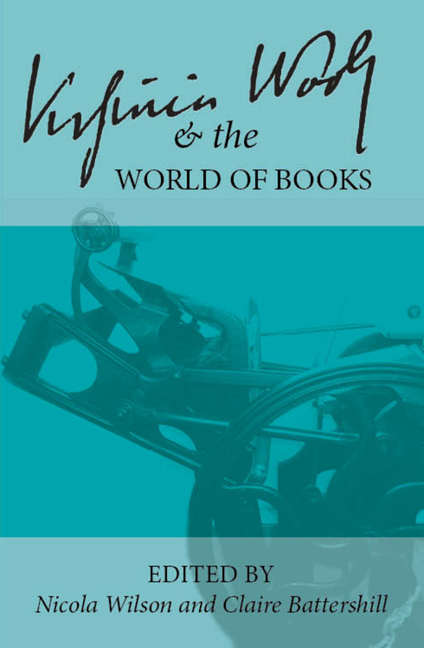 Virginia Woolf and the World of Books
Virginia Woolf and the World of Books Book contents
- Frontmatter
- Contents
- Introduction
- List of Abbreviations
- Keynote
- In the Archives
- Craftsmanship
- The Hogarth Press
- Hours in A Library
- The Art of the Book
- The Art of the Narrative
- Making New Books: Creative Approaches
- The Book in the World: Woolf's Global Reception
- Editing and Teaching Woolf
- Intertextuality
- Virginia Woolf's Appreciation for Walt Whitman's Leaves of Grass: Book Making/Reading, Intimacy, Collectivity
- Reading Intercultural, Intergenerational and Intertextual Woolf: Virginia Woolf's “The Lady in the Looking-Glass,” Oscar Wilde's “The Sphinx without a Secret,” and Lady Murasaki's Yugao
- To “write about Mrs Lindbergh”: Woolf, Flight, and Anne Morrow Lindbergh's North to the Orient
- Lives in Writing
- Notes on Contributors
To “write about Mrs Lindbergh”: Woolf, Flight, and Anne Morrow Lindbergh's North to the Orient
from Intertextuality
- Frontmatter
- Contents
- Introduction
- List of Abbreviations
- Keynote
- In the Archives
- Craftsmanship
- The Hogarth Press
- Hours in A Library
- The Art of the Book
- The Art of the Narrative
- Making New Books: Creative Approaches
- The Book in the World: Woolf's Global Reception
- Editing and Teaching Woolf
- Intertextuality
- Virginia Woolf's Appreciation for Walt Whitman's Leaves of Grass: Book Making/Reading, Intimacy, Collectivity
- Reading Intercultural, Intergenerational and Intertextual Woolf: Virginia Woolf's “The Lady in the Looking-Glass,” Oscar Wilde's “The Sphinx without a Secret,” and Lady Murasaki's Yugao
- To “write about Mrs Lindbergh”: Woolf, Flight, and Anne Morrow Lindbergh's North to the Orient
- Lives in Writing
- Notes on Contributors
Summary
On 27th August 1935, Harold Nicolson gave Woolf a copy of Anne Morrow Lindbergh's North to the Orient (1935), which was a record of the Lindberghs’ attempt to map a new and uncharted air route from America to Asia in 1931. Recently returned from staying with the Lindberghs, he conveyed to Woolf the welcome news of her fame and popularity in America, an important boon for Woolf whose struggles with writing The Years were causing her an “acute despair” (D5 17). The immediate impact was to motivate Woolf to work on her novel, seemingly stimulating her creative faculties. Woolf 's diary records that it “[w]oke my insensate obsession— to write P & P [one possible title for The Years]—by telling me how a room of one's own is regarded & my American fame” (D4 335). Although this renewed impetus was short-lived, in her diary entry that records her writer's block she wonders whether she might “write about Mrs Lindbergh?” (D4 338). This paper will explore how North to the Orient may have prompted Woolf to consider writing about this female pilot whose experience in many ways seems so remote from her own.
The mid-1930s was an intensely fraught and volatile period politically as negotiations and attempts to halt the rise of fascism in Europe repeatedly failed and Woolf, as a pacifist, felt increasingly isolated from friends and family, including Leonard, who supported rearmament as a response to Hitler's increasing power and territorial conquests. As her diary records, she felt “in a stew about war & patriotism” and, “desperate, almost in tears” (D4 335) about being unable to write, she turns to books, specifically John Bailey, 1864–1931, Letters and Diaries (1935) and North to the Orient, for consolation and possibly hope. Both writers represent the literary world (Bailey was a literary critic and Morrow Lindbergh a writer) but they also represent the idea of preservation which resonates with Woolf 's own similar commitments (in relation to literary and English cultural traditions) at this time. Bailey was the chairman of the National Trust for Places of Historic Interest or Natural Beauty, the charitable organization that seeks to preserve English heritage, and Morrow Lindbergh's account of air travel is rich in description of natural beauty and landscapes, and implies the need for preservation.
- Type
- Chapter
- Information
- Virginia Woolf and the World of BooksSelected Papers from the Twenty-seventh Annual International Conference on Virginia Woolf, pp. 268 - 274Publisher: Liverpool University PressPrint publication year: 2018
